Java+MySQ设计系统
Java架构师 人气:01 Scenario 场景
电商系统的促销手段(Electronic Commerce Systems):
- 优惠券
- 拼团
- 砍价
- 老带新
优惠券的种类:
- 满减券
- 直减券
- 折扣券
优惠券系统的核心流程:
发券
发券的方式: 同步发送 or 异步发送
领券
- 谁能领?
- 所有用户 or 指定的用户
- 领取上限
- 一个优惠券最多能领取多少张?
- 领取方式
- 用户主动领取 or 自动发放被动领取
用券
- 作用范围
- 商品、商户、类目
- 计算方式
- 是否互斥、是否达到门槛等
需求拆解
商家侧:
- 创建优惠券
- 发送优惠券
用户侧:
- 领取优惠券
- 下单
- 使用优惠券
- 支付
2 Service 服务
2.1 服务结构设计
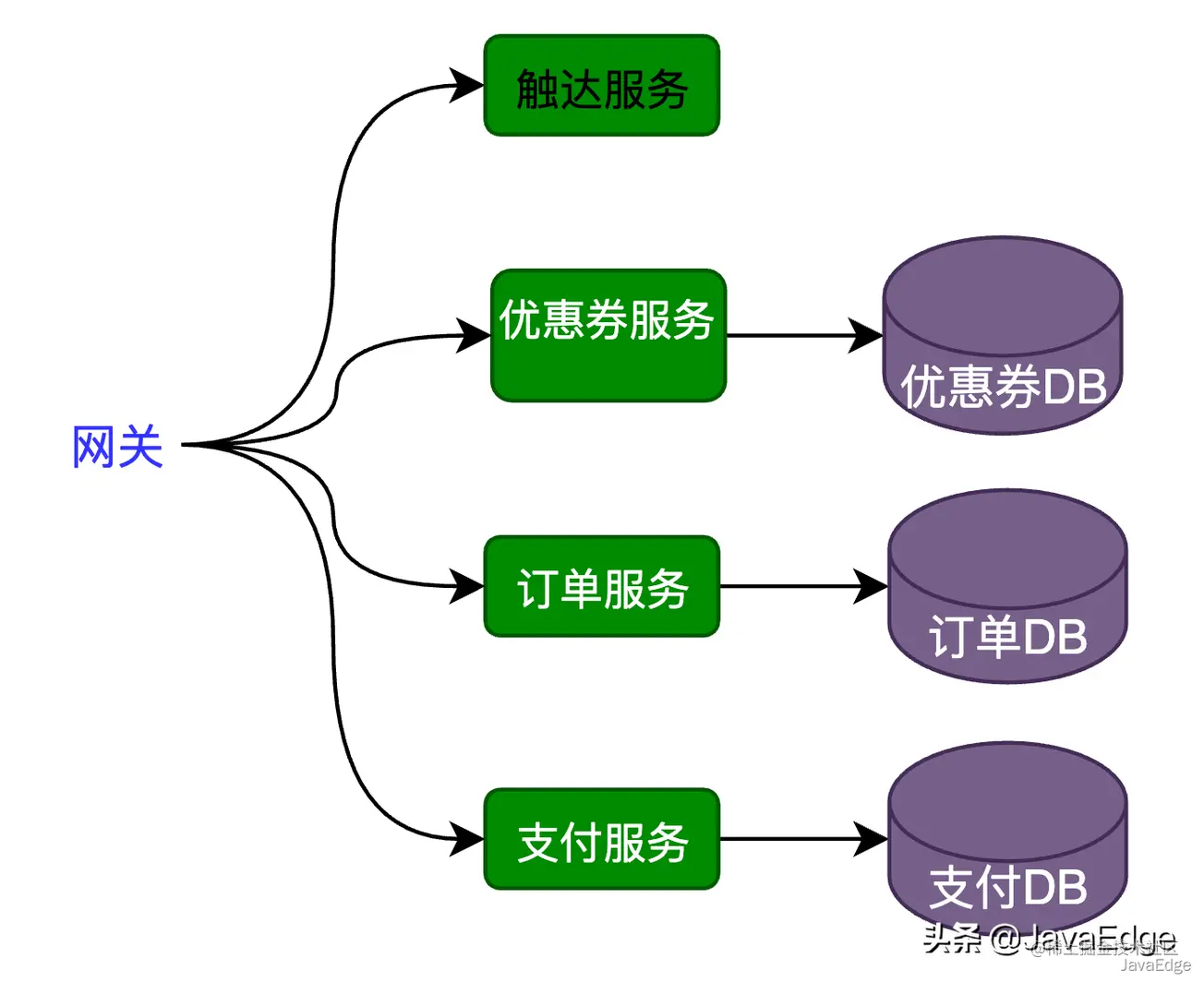
2.2 优惠券系统难点
券的分布式事务,使用券的过程会出现的分布式问题分析
如何防止超发
如何大批量给用户发券
如何限制券的使用条件
如何防止用户重复领券
3 Storage存储
模型的设计
优惠券系统 Coupon System 模型定义
优惠券系统的难点
3.1 表单设计
券批次(券模板),coupon_batch
指一批优惠券的抽象、模板,包含优惠券的大部分属性。
如商家创建了一批优惠券,共1000张,使用时间为2022-11-11 00:00:00 ~ 2022-11-11 23:59:59,规定只有数码类目商品才能使用,满100减50。
券
发放到用户的一个实体,已与用户绑定。
如将某批次的优惠券中的一张发送给某个用户,此时优惠券属于用户。
规则
优惠券的使用有规则和条件限制,比如满100减50券,需要达到门槛金额100元才能使用。

券批次表 coupon_batch
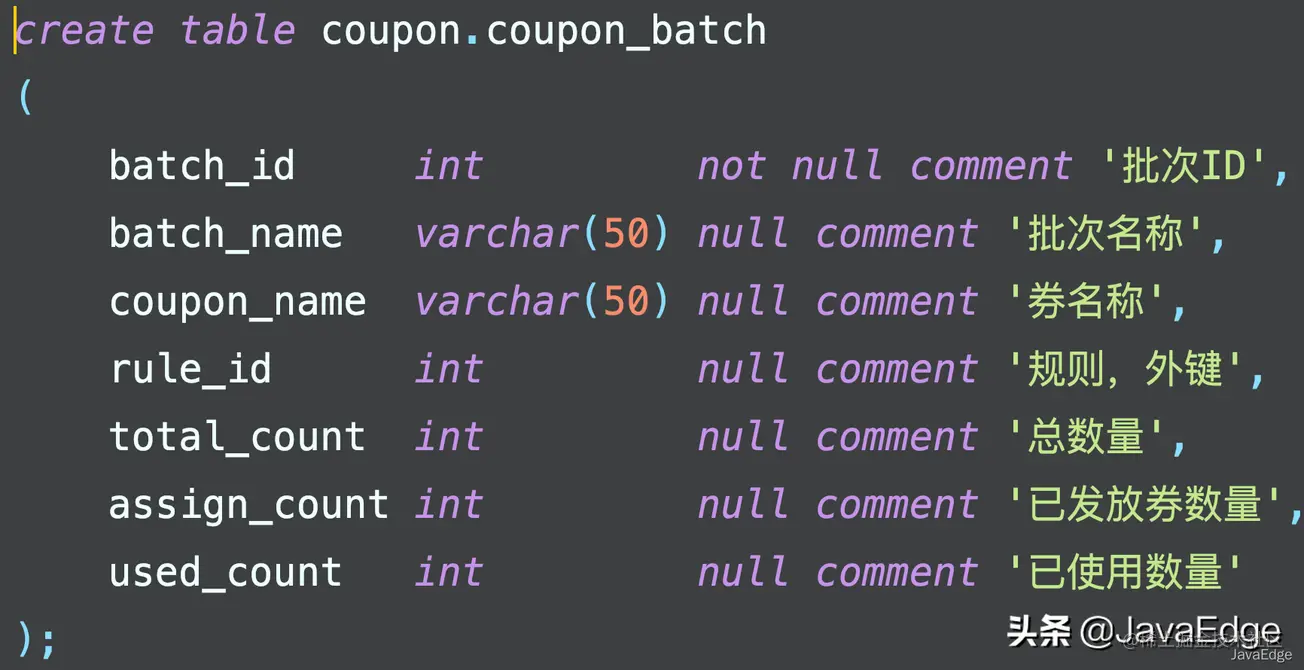
规则表 rule:

规则内容:
{
threshold: 5.01 // 使用门槛
amount: 5 // 优惠金额
use_range: 3 // 使用范围,0—全场,1—商家,2—类别,3—商品
commodity_id: 10 // 商品 id
receive_count: 1 // 每个用户可以领取的数量
is_mutex: true // 是否互斥,true 表示互斥,false 表示不互斥
receive_started_at: 2020-11-1 00:08:00 // 领取开始时间
receive_ended_at: 2020-11-6 00:08:00 // 领取结束时间
use_started_at: 2020-11-1 00:00:00 // 使用开始时间
use_ended_at: 2020-11-11 11:59:59 // 使用结束时间
}优惠券表 coupon:
create table t_coupon
(
coupon_id int null comment '券ID,主键',
user_id int null comment '用户ID',
batch_id int null comment '批次ID',
status int null comment '0-未使用、1-已使用、2-已过期、3-冻结',
order_id varchar(255) null comment '对应订单ID',
received_time datetime null comment '领取时间',
validat_time datetime null comment '有效日期',
used_time datetime null comment '使用时间'
);3.2 优惠券系统
建券:
1、新建规则
INSERT INTO rule (name, type, rule_content)
VALUES(“满减规则”, 0, '{
threshold: 100
amount: 10
......
}');2、新建优惠券批次
INSERT INTO coupon_batch (coupon_name, rule_id, total_count ) VALUES(“劳斯莱斯5元代金券”, 1010, 10000);
发券:
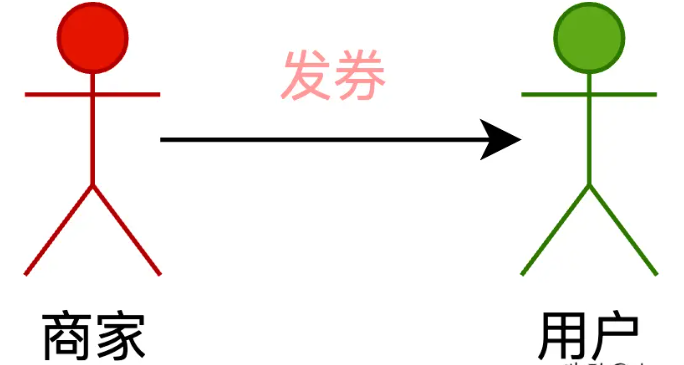
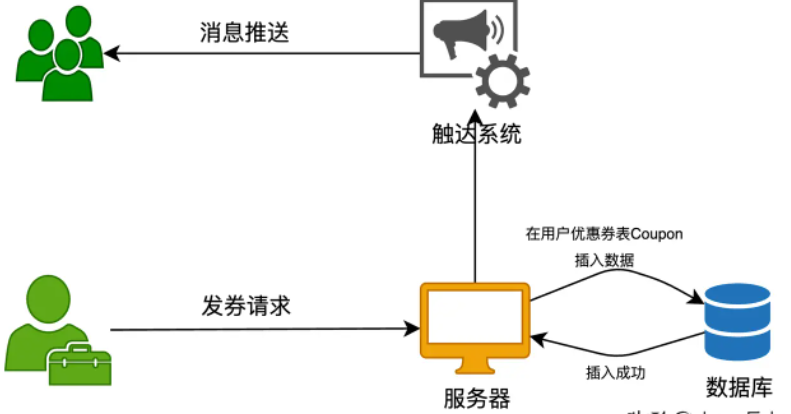
如何给大量用户发券?
异步发送
触达系统
- 短信、邮件
- 可通过调用第三方接口的方式实现
- 站内信
- 通过数据库插入记录来实现
信息表 message
create table t_message
(
id int null comment '信息ID',
send_id int null comment '发送者id',
rec_id int null comment '接受者id',
content vachar(255) comment '站内信内容',
is_read int null comment '是否已读',
send_time datetime comment '发送时间'
)
comment '信息表';先考虑用户量很少的情况,商家要给所有人发站内信,则先遍历用户表,再按照用户表中的所有用户依次将站内信插入到 message 表中。这样,如果有100个用户,则群发一条站内信要执行100个插入操作。
系统用户数增加到万级
发一条站内信,就得重复插入上万条数据。而且这上万条数据的 content 一样!假设一条站内信占100K,发一次站内信就要消耗十几M。对此,可将原来的表拆成两个表:
信息表 message

信息内容表 message_content

发一封站内信的步骤
- 往 message_content 插入站内信的内容
- 在 message 表中,给所有用户插入一条记录,标识有一封站内信
千w级用户数
这就有【非活跃用户】的问题,假设注册用户一千万,根据二八原则,其中活跃用户占20%。若采用上面拆成两个表的情况,发一封“站内信”,得执行一千万个插入操作。可能剩下80%用户基本都不会再登录,其实只需对其中20%用户插入数据。
信息表 message:
create table t_message
(
id int null comment '信息 ID',
# send_id int null comment '发送者 id', 去除该字段
rec_id int null comment '接受者 id',
message_id int null comment '外键,信息内容',
is_read int null comment '是否已读'
)
comment '信息表'; create table t_message_content
(
id int null comment '信息内容id',
send_id int null comment '发送者id',
content varchar(255) null comment '内容',
send_time datetime null comment '发送时间'
);用户侧操作
登录后,首先查询 message_content 中的那些没有在 message 中有记录的数据,表示是未读的站内信。在查阅站内信的内容时,再将相关的记录插入 message。
系统侧操作
发站内信时:
- 只在 message_content 插入站内信的主体内容
- message 不插入记录
假设商家要给 10W 用户发券:
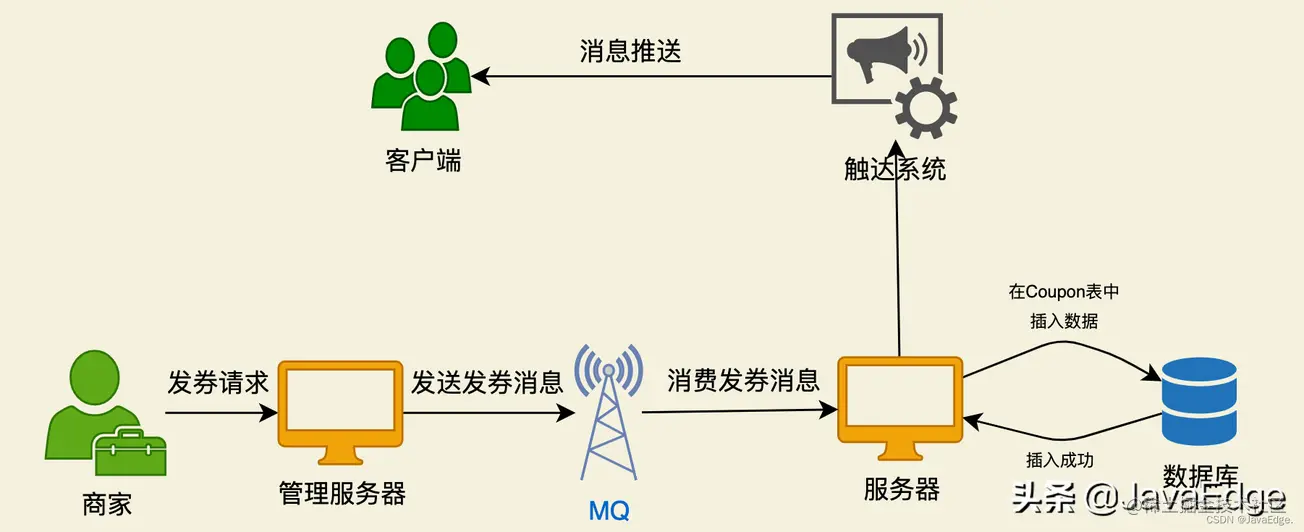
有什么问题?重复消费,导致超发!
- 运营提供满足条件的用户文件,上传到发券管理后台并选择要发送的优惠券
- 管理服务器根据【用户ID】、【券批次ID】生成消息,发送到MQ
- 优惠券服务器消费消息
# 记住使用事务哦!
INSERT INTO coupon (user_id, coupon_id,batch_id)
VALUES(1001, 66889, 1111);
UPDATE coupon_batch SET total_count = total_count - 1,
assign_count = assign_count + 1
WHERE batch_id = 1111 AND total_count > 0; 领券
步骤:
- 校验优惠券余量
SELECT total_count FROM coupon_batch WHERE batch_id = 1111;
- 新增优惠券用户表,扣减余量
# 注意事务!
INSERT INTO coupon (user_id, coupon_id,batch_id)
VALUES(1001, 66889, 1111);
UPDATE coupon_batch SET total_count = total_count - 1,
assign_count = assign_count + 1
WHERE batch_id = 1111 AND total_count > 0;用户领券过程中,其实也会出现类似秒杀场景。秒杀场景下会有哪些问题,如何解决?

解决用户重复领取或多领:
Redis 数据校验!
- 领券前,先查缓存
# 判断成员元素是否是集合的成员 SISMEMBER KEY VALUE SISMEMBER batch_id:1111:user_id 1001
- 领券
- 领券后,更新缓存
# 将一或多个成员元素加入到集合中,已经存在于集合的成员元素将被忽略 SADD KEY VALUE1......VALUEN SADD batch_id:1111:user_id 1001
用券
何时校验优惠券使用规则?
- 确认订单(√)
- 提交订单
- 立即付款
确认订单页,对优惠券进行校验:
- 判断是否过期
- 判断适用范围
- 判断是否达到门槛
- 判断是否互斥
返回可用券

SELECT batch_id FROM coupon WHERE user_id = 1001 AND status = 0; SELECT rule_id FROM coupon_batch WHERE batch_id = 1111; SELECT name, type, rule_content FROM rule WHERE rule_id = 1010; 复制代码
选择可用券,并返回结果

同时操作多个服务,如何保证一致性?
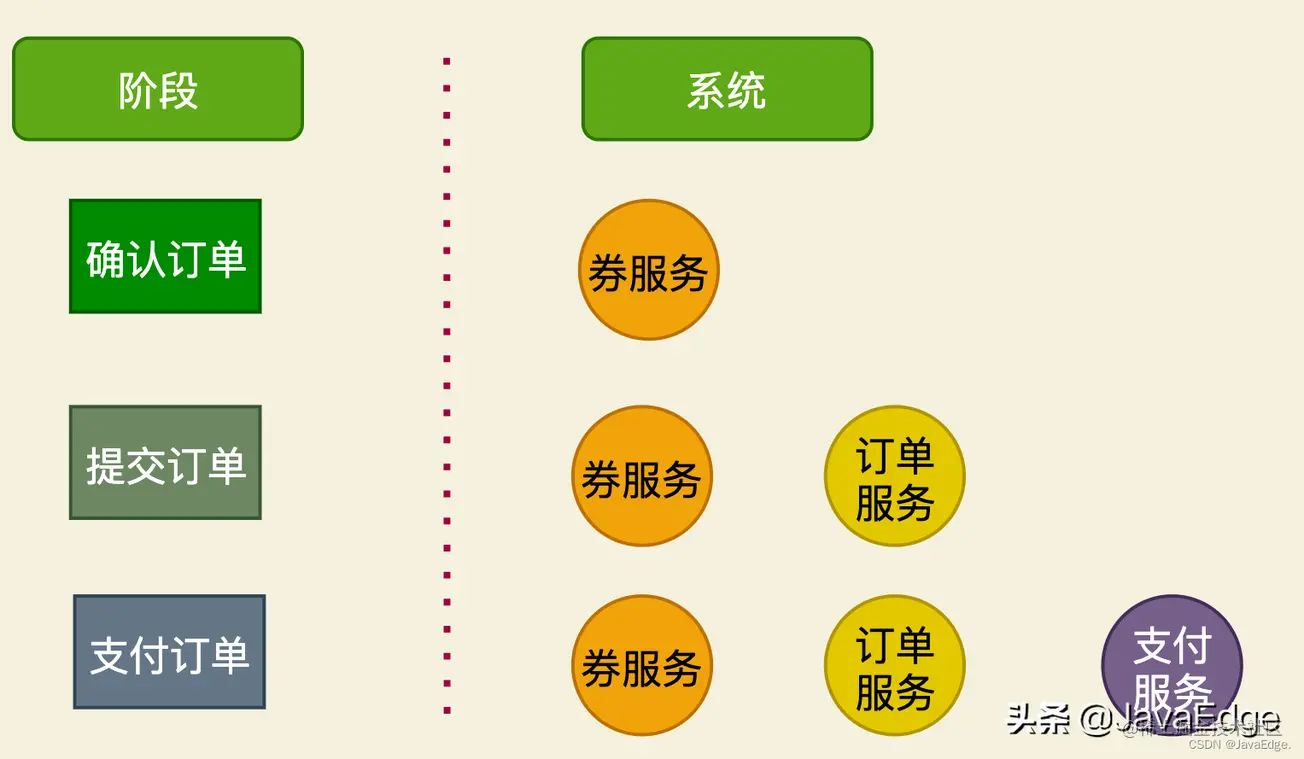
表设计
优惠券操作记录表 Coupon_opt_record
create table t_coupon_opt_record
(
user_id int null comment '用户id',
coupon_id int null comment '优惠券id',
operating int null comment '操作,0-锁定、1-核销、2-解锁',
operated_at datetime null comment '操作时间'
);TCC,Try-Confirm-Cancel,目前分布式事务主流解决方案。
阶段一:Try
对资源进行冻结,预留业务资源
创建订单时,将优惠券状态改为 “冻结”
阶段二:Confirm
确认执行业务操作,做真正提交,将第一步Try中冻结的资源,真正扣减
订单支付成功,将优惠券状态改为 “已使用”
阶段三:Cancel
取消执行业务操作,取消Try阶段预留的业务资源
支付失败/超时或订单关闭情况,将优惠券状态改为 “未使用”
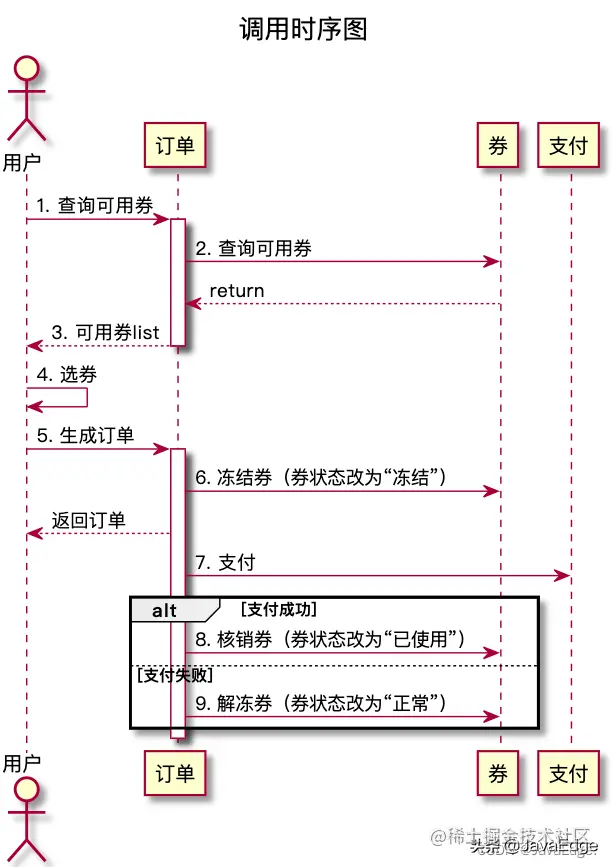
Scale扩展
快过期券提醒:
定时扫券表:
缺点:扫描数据量太大,随着历史数据越来越多,会影响线上主业务,最终导致慢SQL。
延时消息:
缺点:有些券的有效时间太长了(30天)以上,有可能造成大量 MQ 积压
新增通知表:
优点:扫描的数据量小,效率高。删除无用的已通知的数据记录
通知信息表(notify_msg)设计
create table t_notify_msg
(
id bigint auto_increment comment '自增主键',
coupon_id bigint null comment '券id',
user_id bigint null comment '用户id',
notify_day varchar(255) null comment '需要执行通知的日期',
notify_type int null comment '通知类型,1-过期提醒',
notif_time timestamp null comment '通知的时间,在该时间戳所在天内通知',
status int null comment '通知状态,0-初始状态、1-成功、2-失败',
constraint t_notify_msg_id_uindex
unique (id)
);
alter table t_notify_msg
add primary key (id);过期券提醒:
- 在创建优惠券的时候就将需要提醒的记录插入提醒表中notify_msg
- 把用户ID+批次ID+通知日期作为唯一索引,防止同一个批次有重复的记录通知,保证每天只会被通知一次
- 建立notify_time,通知时间索引,每日的通知扫描通过该索引列查询,通过索引列来提高查询效率
- 通知完成后该表中的数据变失去了意义,通过定时任务将该数据删除
数据库层面优化 - 索引
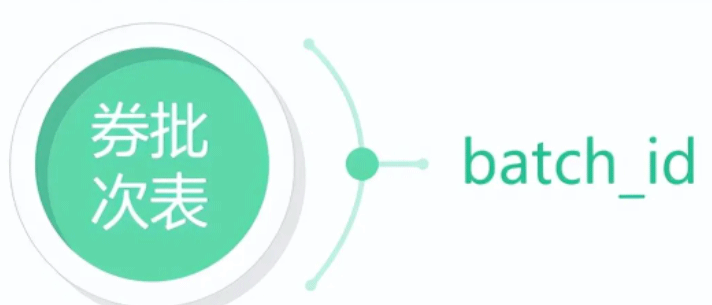
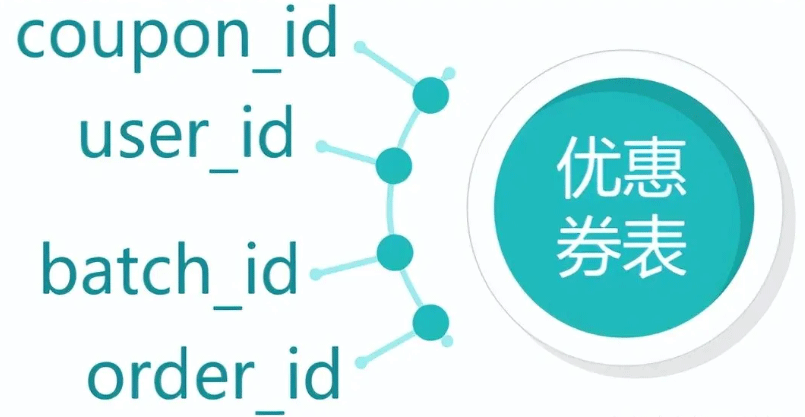
发券接口,限流保护
前端限流:
点击一次后,按钮短时间内置灰
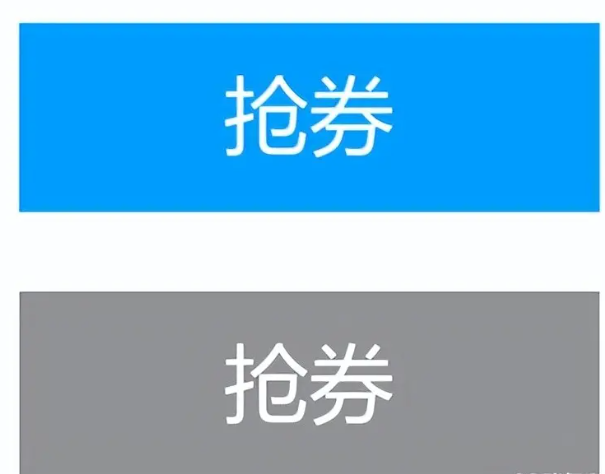
后端限流:
部分请求直接跳转到【繁忙页】
加载全部内容